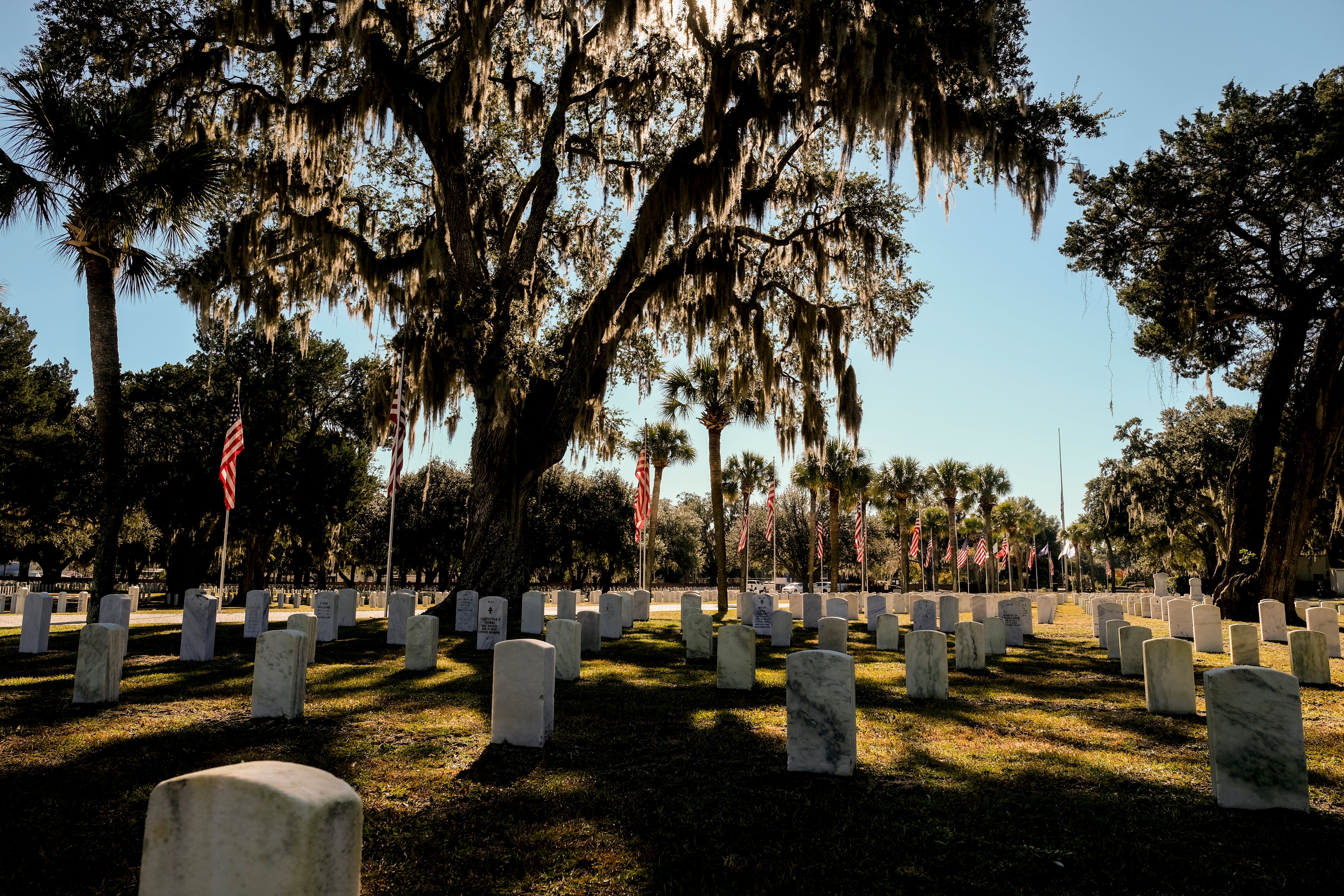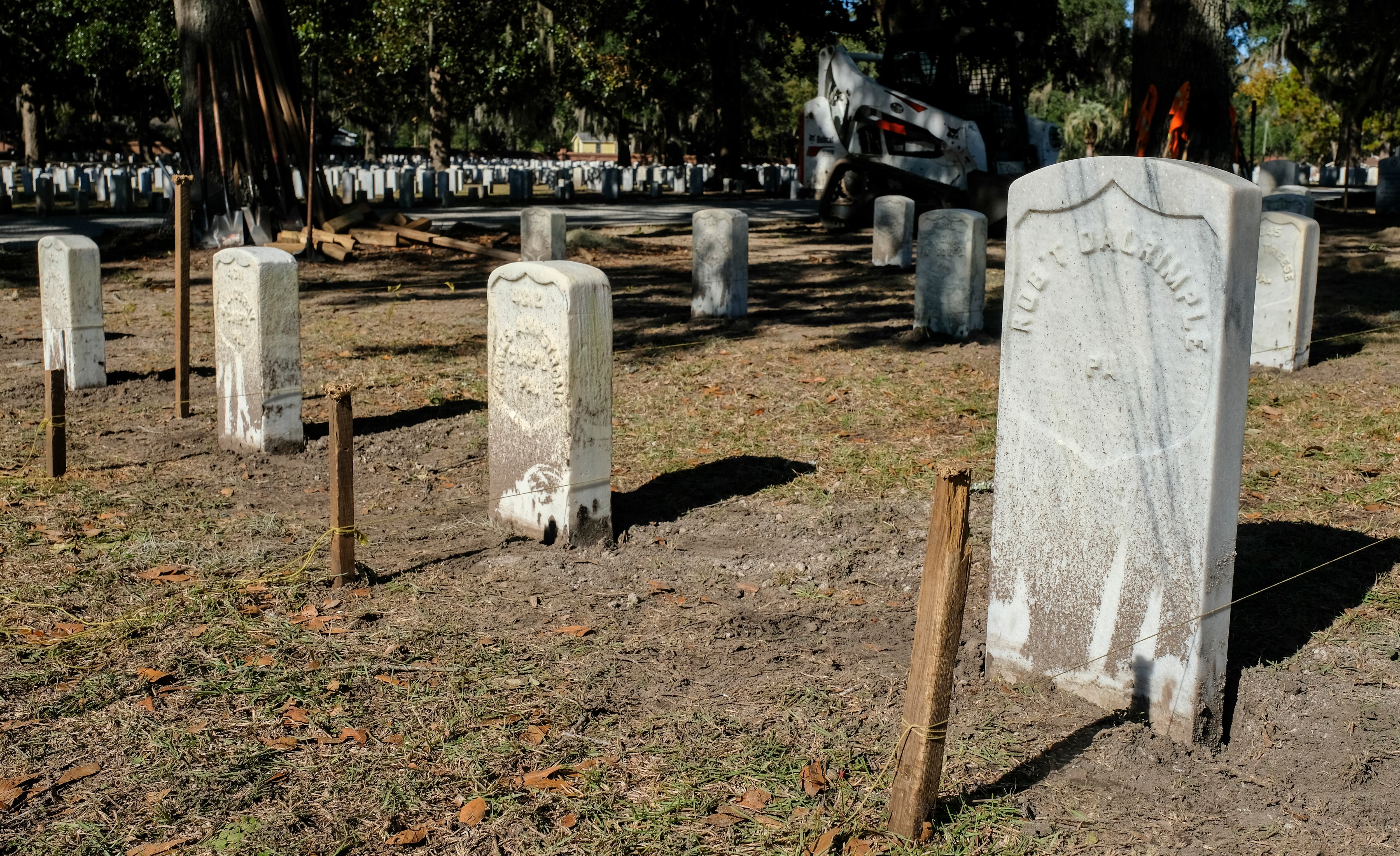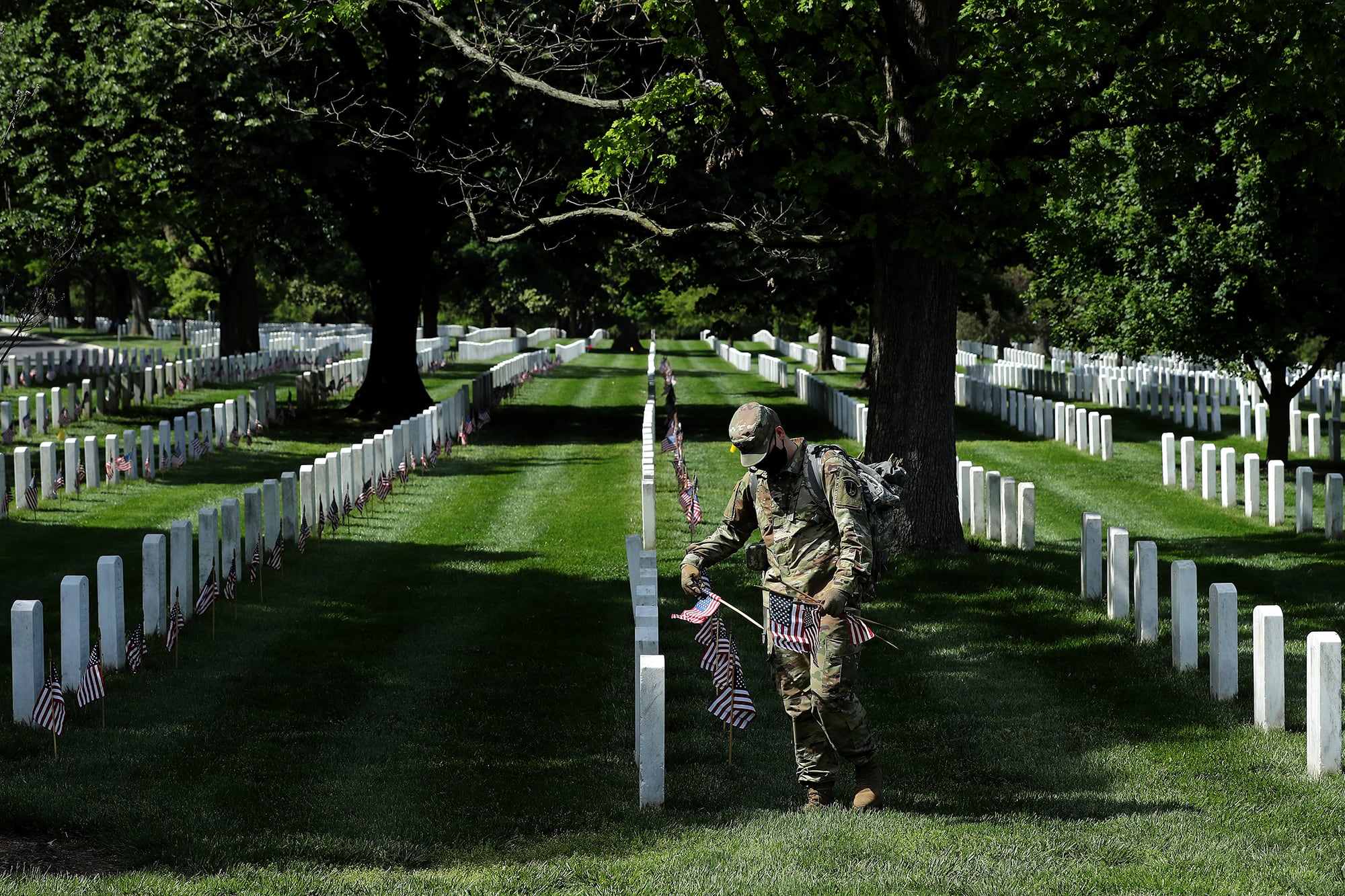BEAUFORT, S.C. — Staff Sgt. John Bentley and Pfc. Esteban Villa stepped toward each other as the U.S. flag they folded grew smaller. Wearing white gloves, they tucked and patted it, just so, and communicated in whispers — “Ready, fold.” “Ready, turn.”
Then, the young soldiers from Fort Stewart turned crisply toward a couple in their 70s, Charlie Read Jr. and his wife, Alice, seated in the front row. On behalf of a grateful nation, a triangle-shaped flag as tight as a button was presented for the World War II service of Charles Read Sr. and Valerie Leyrer Read, veterans who were Read’s parents. Charlie wiped away tears but described the service afterward as a “happy event.”
“They were inseparable in life,” Read, of Sun City, said of his parents. “And here they will be together for eternity.”
Life goes on in 2021 at the Beaufort landmark, 158 years after President Abraham Lincoln created it. Here you can find 9,000 Civil war veterans, including Black troops and Confederates — who sometimes lie side by side — along with men and women from all wars. Soldiers, sailors and airmen continue to be buried here today, just as they did during the Civil War.
Like the Reads, all veterans get ceremonies with military honors and secure final resting places underneath towering live oaks and palmetto trees. There is no cost.
But time is catching up with the old graveyard where more than 30 U.S. flags lined “Palmetto Drive” for Veterans Day.

More than 17,000 headstones have begun to lean or sag, or both, due to the shifting ground. Those headstones are now being fixed as part of a $3.1 million overhaul. A longer-term, age-related issue can’t be resolved as easily: Beaufort National Cemetery, spread across three city blocks and 44 acres, could be out of room in 15 to 20 years, marking its end as an active cemetery.
“There’s really no area to further expand,” says Jeff Applegate of the National Cemetery Administration, the assistant director of the cemetery.
Memorial services return
The cemetery, one of the oldest final resting places for veterans in the nation, features 26,959 headstones honoring veterans from the Civil War to the war in Afghanistan. It’s located off one of Beaufort’s busiest streets, behind a brick wall.
An estimated 2,500 people visit the eternal oasis each month, making it one of the city’s biggest attractions, drawing not only families with loved ones but also historians and returning Marines who trained at nearby Marine Corps Recruit Depot-Parris Island or Marine Corps Air Station-Beaufort, Applegate says.
The cemetery’s deep connection to the nation’s Civil War history, age, idyllic setting and the unusual way in which it was designed, make it a serene fixture in changing times.
“It’s changed in small increments,” Applegate says, “but it really hasn’t changed since they first designed it.”
Laid out in the shape of a half-wheel, its oyster shell roads, originating at the hub, form the spokes, and live oaks, magnolias and palmetto trees tower over it.
Then came COVID-19 in early 2020. The pandemic initially ended the memorial services, with only direct burials allowed for several months to avoid the spread of the virus. Services eventually returned, but with restrictions on crowd size. Many people postponed interments or memorial services until the ceremonies were allowed again in late 2020.
Now services are back to normal. In fiscal year 2021, which ended Sept. 30, interments jumped to a near-record 729, a 28 percent increase, after slipping to 567 in 2020.
‘A tough gig’
“Look at it,” Read said, standing in the shade of live oak trees and gesturing to the sea of tombstones, moments before his parents’ ceremony. “It’s beautiful. It doesn’t get any nicer than this.”
Charlie Read’s parents, Suffolk County, New York natives, died just four months apart in 2001 in Chester County, Pennsylvania. His mother was the first woman in the United States to become a county commander within American Legion, Read said. His father was elected commander a few years later. She was a homemaker. He was a locomotive engineer. At the end of WWII, both served in the Army stateside, he as a heavy machine gunner in the infantry, she as an x-ray technician in Army Medical Corps.
A retired Air Force major, former trooper with the New York State Police and former special agent with the Pennsylvania Attorney General’s Office, Read knew almost immediately that Beaufort National Cemetery was the right place for his parents after visiting on Memorial Day. To be sure, the history and beauty stood out. But Read also noticed that husbands and wives were co-interred, with their information on each side of the headstone, which made an impression.
He was so moved by the Nov. 9 ceremony for his parents that he caught up with the military honor guard members afterward to offer his hand and thanks. “I know it’s a tough gig,” he told them, still teary-eyed.

Beaufort National Cemetery has been around since Feb. 10, 1863, two years before the end of the Civil War, when Lincoln created 13 national cemeteries needed for the growing numbers of war dead. Initially, interments came from Civil War soldiers who had died at hospitals or battlefields. Over time, veterans from nine additional wars, in addition to peacetime veterans and, in some cases, spouses, young children or adults who are fully dependent, joined them.
Today, it is one of 155 national veterans’ cemeteries. Of those, 75 remain active. Eventually, Applegate says, cemeteries run out of room and stop allowing new burials. That process has happened more quickly at cemeteries in the East compared to larger cemeteries in the West, Applegate says.
Hemmed in by houses
In 2009, the 30-acre historic part of Beaufort National Cemetery, the part surrounded by the brick wall, was expanded by 10 to 15 acres in the back, outside the wall. Today, most burials are conducted there.
But, hemmed in by houses, Beaufort National is projected to reach capacity in 2035 or 2040, the Cemetery Administration, which is part of the Veterans Administration, Applegate said. If it closes to new interments, the cemetery would still remain open to the public, but a search would likely begin for 200 to 300 acres in the region for a new cemetery to be developed, he said.
“But not one of those decisions has been made yet,” Applegate said.
RELATED

For the immediate future, a $3.1 million project is underway to raise and realign an estimated 17,445 markers that have settled and moved over time in the 30-acre historic section. It requires a full-time crew painstakingly removing each marker, putting aggregate below to stabilize it, then reinstalling it and making sure the alignment and height are correct.
A new irrigation system also will be installed at the same time. A grass that survives better underneath the big trees also will be planted. The entire project is expected to be done by May 2022.
‘A blank check’
Cemetery representative Louis Brown II greeted the Reads when they arrived for the ceremony. Lights flashing on his vehicle, Brown led the two-vehicle procession to a small shelter, where the flag ceremony and the playing of “Taps” by Pfc. Oscar Cardona was complete in 10 minutes.
Then cemetery caretaker Alex Garcia placed the small urns in the ground. Markers have been ordered that will say, “I ran out of steam,” for Charles Read Sr., who worked for the Long Island Railroad, and “I’ll make reservations,” for Valerie Read, who loved going out for a ride and dinner.
Charlie Read pointed down the line of gravestones. His parents, he said, will be joining their “brothers and sisters.” “They all wrote the blank check,” Read said. “They put it all on the line.”
Read and his wife have decided that they, too, will be buried at Beaufort National Cemetery.
